Big Red Book
Celebrating television's This Is Your Life
Birth of Life

Roy Bottomley, former national newspaper journalist, television news editor, producer and writer of television comedy, drama and documentaries, was involved in every This Is Your Life edition from when the series began broadcasting on ITV in 1969 until 1995.
In his book This Is Your Life: The Story of Television's Famous Big Red Book, published in 1993, he looked back at the programme's genesis and how it all grew out of a small section on a radio programme in post-war America...
related pages...
a brief biography
tributes to the original presenter
the studio look and locations
the show's fifty year history
the man who created it all
first-hand recollections
The Story of This Is Your Life
a BBC Did You See...? special
Snoopers on TV? Not on your life!
The Daily Express reports on an American import
Radio Times previews the first edition
What A Surprise For Eamonn Andrews
Press reviews of the programme's first edition
Eamonn Is Back On Monday For This Is Your Life
Gale Pedrick looks ahead to the new series
Torture, Treacle, Tears and Trickery
The Controversy Surrounding This Is Your Life in the 1950s
Eamonn Andrews previews the programme's relaunch
TV Times previews the new series
Press coverage of the death and memorial service of Eamonn Andrews
Andrews's death casts doubt on his show
The Guardian reports the death of Eamonn Andrews
This Is Your Life's creator dies
BBC report on the death of Ralph Edwards
Stanley Matthews should have been on the first This Is Your Life
Look and Learn magazine feature
Somewhere, Someone - This Is Your Life
Talk of Thames feature on the programme's 1969 relaunch
The Origin of This Is Your Life
A comprehensive account of how it all started
TV Times celebrates This Is Your Life
How do you sit down and come up with the idea of This Is Your Life? It is the question the production team is most frequently asked.
The short answer is: you don't. Television's most enduring format was not really invented; it evolved from something quite different.
Let me take you back, as a Life script might say, to the NBC station in Hollywood, 27 April 1946, where a young radio producer/emcee is presenting an unusual act on his Truth or Consequences show, one of the top-rated prime-time radio network shows of all time.
He is Ralph Edwards, who started working as a radio announcer while in high school in Oakland, California. Following graduation from the University of California, Berkeley, as an English major, he attacked New York and quickly became one of the most in-demand network announcers ever - heard on over forty shows a week.
In 1940 Ralph Edwards created Truth or Consequences, an audience participation show with no limitations: zany stunts, fantastic contests, and many 'good gesture' acts.
During the Second World War he persuaded his listeners to purchase over half a billion dollars in war bonds, for which he was presented with a special General Eisenhower Award. After the war, Ralph Edwards went to the Veterans' Administration in Washington and asked if he could be of help... particularly to returning war-wounded.
General Omar Bradley had charge of the Veterans' Administration. He thought Edwards could be useful and put him in touch with a service psychologist at a Veterans' Hospital in Long Beach, California. Ralph, talking to me at his home in Beverly Hills, said, 'They told me wounded, paraplegic boys were often afraid to go home, fearful they wouldn't be accepted and properly cared for. I decided to devote a segment of Truth or Consequences to wounded service men, reuniting them with friends and getting them to talk about their past.'
They decided to present a young ex-marine, Lawrence Tranter of Murray, Utah, on Truth or Consequences and surprise him with a show of love and pride from all of his family and school pals, his boss at the drug store and his favourite teacher. 'This Is Your Life Past' said Ralph, 'now, what about the future?' Knowing that Tranter was interested in watchmaking, Ralph arranged for Lawrence Tranter to be trained at the Bulova School of Watchmaking with a promise to help him open a jewellery shop of his own in the city of his choosing. 'Training completed two years later, Tranter returned to the radio programme – his wheelchair pushed by a lovely girl with red tresses, his wife,' said Ralph.
As all of this unfolded, Ralph realised he had a great new show and This Is Your Life began on radio (NEC network) in 1948. (In the meantime, Truth or Consequences continued as a hit radio and television show for thirty-eight years.)

This Is Your Life premiered on NBC Television on 1st October 1952
This Is Your Life ran on network radio (NEC) for two years before transferring to television (also NBC) in 1952. Ralph Edwards featured outstanding people, from stars like Laurel and Hardy and Bette Davis to a Chicago cab driver, a character who even had coffee in the back of his cab for his customers.
The cab driver's name was Eddie Hamilton, and on the day of the programme there was a 'leak' to a newspaper that he was to be the guest of honour. To make sure he never got a chance to see the newspaper, Ralph's team became his non-stop 'fares' for the day, until the last 'fare' asked to be taken to the Studebaker Theatre where Ralph was waiting with the book.
More recently, we had the same experience with comedian Ken Dodd. Tickled we weren't when a national newspaper gossip columnist revealed that Michael Aspel would surprise him that day. Luckily for us, Doddy - who works nights, of course - is a late sleeper. Even more fortunate, his managers were in discussion at the time with Thames TV executives about a variety 'special' from the London Palladium.
So a 'cordon' was thrown around Ken, who found himself involved in all-day meetings, with hardly a chance for a cup of coffee, let alone reading any newspapers.
He was astonished when Michael Aspel pounced, just outside the Palladium. Said the comedian: 'Michael, that really put the wind up me. I thought you were the VAT man.'
It was almost by accident that the Life came to British television. The year was 1955, and Eamonn Andrews was sent to San Francisco in his capacity as boxing commentator (for many, the best in the business). The fight was between US Champion Rocky Marciano and Britain's Don Cockell.
Eamonn was already a BBC Television star, as host of What's My Line? Now the BBC were seeking another show for him to present. Before Eamonn left for America, Ronnie Waldman, head of BBC Light Entertainment, took him on one side and said he had been hearing a great deal about a certain programme on NBC. 'Take a look at it and let me know what you think. It's called This Is Your Life.'
Eamonn once told me: 'Well, I had a look at it, saw an American named Ralph Edwards presenting it, and my first reaction was: this is television. I immediately cabled Ronnie Waldman and told him it was a programme I would very much like to do.'
In the rarefied atmosphere of the BBC's corridors of power in the mid-Fifties, the Life idea was greeted with something less than enthusiasm. Telerecordings of the American version were sent for. There was much executive hand wringing. It simply wasn't 'a BBC programme'.
Whenever we discussed this crucial period - would the Life make it to British screens? - Eamonn always reckoned it was one American edition in particular which finally persuaded the BBC hierarchy to give it a trial run. It was a Life on the Hollywood film actor Victor McLaglen. His seven brothers, all as well built as the star himself, flew in from all parts of the world for the reunion, bringing tears to those famous craggy features. But they brought a smile to Eamonn's, because those touching scenes did the trick with the powers-that-were in the BBC.
So Eamonn and the Life got the green light, though caution was hardly thrown to the winds: the programme would be transmitted on a monthly basis. In the television business that usually means someone is ready for it to disappear quietly from the schedules without too many red faces.
Red faces were soon everywhere when the worst that could possibly happen to the first British programme happened in spades.
Ralph Edwards was to present the first programme. He and his director, Axel Gruenberg, a great bear of a man, but prone to tears when directing emotional moments, arrived in London. Pretty soon Axel had good reason for tears.
The Americans looked at a shortlist of likely candidates for this first programme. Soccer legend Stanley Matthews was chosen. Unfortunately, a national newspaper had also drawn up its own shortlist and hit on Matthews by a process of elimination. At least, that was their story. Others thought it might have been a tip-off. Either way, when the long-since-folded Daily Sketch broke the story, it was bad news indeed for the group meeting in Ralph Edwards's St James Court flat. Eamonn told me, 'I'll never forget that day. I just felt numb.'
As well he might; all the research had been done, the script written, guests invited. Matthews himself was away fishing. Was there a chance the news of the 'leak' wouldn't reach him?
It was explained to the American that that was much more likely back home, where most newspapers are local. In Britain, where many are national, it was highly improbable that Matthews would not be aware of the story.
Ralph said that sometimes, even though the person had been told, he could pull it off. Tom Sloan, the new head of BBC Light Entertainment, said 'No, Mr Edwards, you've come all this way to show us how to do surprises – now surprise us.'
There was no programme being lined up in reserve; the chances of This Is Your Life making British screens in just four days' time looked remote.
Eamonn left the room for a moment. By the time he returned Ralph, Axel and the group had made a decision - the first subject of the Life here would be Eamonn himself. But the name they gave Eamonn was that of former world light-heavyweight boxing champion Freddie Mills.
With his boxing connections, Eamonn knew Freddie well. As a 'cover', a sports special was fixed up. Freddie would be a member of the panel, with Eamonn in the chair. Eamonn was given responsibility for luring Freddie into what would turn out to be the Life set-up.
Meanwhile, behind Eamonn's back, researchers were ferreting into his own story. His wife Grainne had told him she had to see her doctor. Eamonn was puzzled when he rang the doctor's and she wasn't there. She had gone on to do some shopping, she explained.
Eamonn and Grainne entertained Freddie Mills to dinner at their flat.
'I worked very hard on Freddie,' said Eamonn, then: 'To give him his due, he worked very hard on me.'
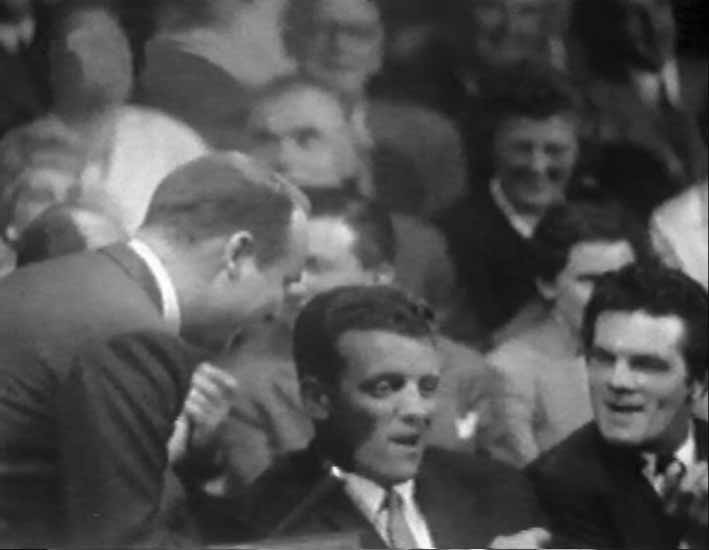
Ralph Edwards presented the first This Is Your Life book on British television to Eamonn Andrews
Freddie accepted Eamonn's invitation to go along with him to see this new programme from America in the studio next door to where the sports special was happening.
Ralph Edwards, as presenter, walked among the audience, sprinkled with names who might be likely subjects. He stopped at where Eamonn was sitting with Freddie Mills. But he handed the book to Eamonn.
'This Is Your Life... oh, blimey... Eamonn Andrews...' read Eamonn out loud.
'I was in a daze,' he told me later. He was in a greater daze when, twenty years later and in response to an endless stream of letters, we trapped him again, this time for Thames TV.
On that occasion, Eamonn wanted a moving story with which to close the season. He was delighted when we told him we had found just the person – a heroic English missionary, returning home after a lifetime in Africa.
What Eamonn didn't know was that this particular hero did not exist.
A totally fictitious script was written. Eamonn rang the Life office from his dressing room to complain it simply wasn't human enough. On the fifth floor the team were working on his own Life, not knowing he was in the building. He had a day off - but had called in to collect some mail from his dressing room. All the evidence was swept off the desks in case he popped in.
Our plan was simple. Eamonn would be invited to make a guest appearance at the Teddington Studios - ten miles from the Euston offices and studios where Life was based at the time - on the David Nixon Show. David, that great magician, was a good friend from the earliest days of What's My Line? at the BBC, and had been a Life subject himself.
In fact, on that pick-up Eamonn had thought it was the end of his own life - literally. The idea was a trick in which David's magic associate Ali Bongo climbed into a sack, and, hey presto, out of the same sack came magician's assistant Penny Meredith.
It being a Christmas Show, it was Santa's sack. Without giving away Magic Circle confidences, Eamonn switched places with Penny, for whom the sack had been a comfortable fit. Not so for Eamonn. Not only was he like a trussed chicken in there, but David Nixon decided he would ad-lib a bit (as he often did), with Eamonn rapidly running out of air. 'Had David not opened the sack when he did I think it would have exploded,' said Eamonn, who just about managed to summon the wind to say the four magic words.
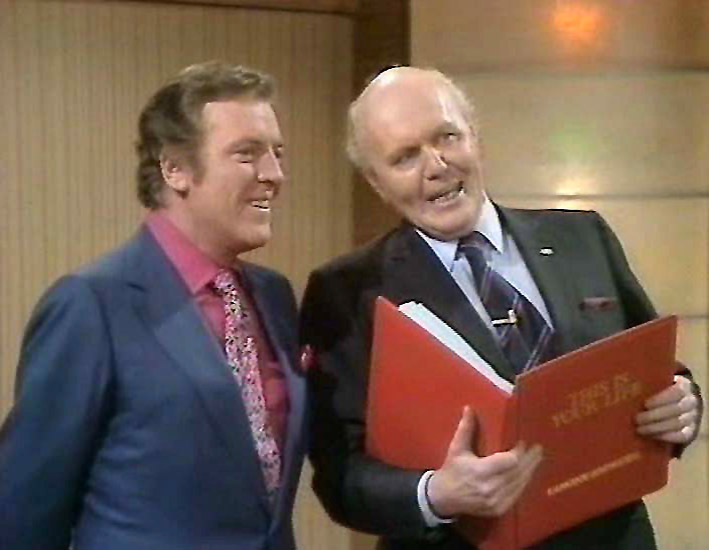
Magician David Nixon presents This Is Your Life host Eamonn Andrews with the Big Red Book
Now it was David's turn to get his own back.
But how to trick Eamonn?
It was his routine to telephone his wife and family in Dublin from his dressing room, after presenting the Today programme most evenings.
We arranged for there to be a 'fault' on the line, and the call had to go through the Thames Television switchboard.
So it was switched to Grainne, safely across the Irish Sea at our Teddington Studios. But when they spoke, in Eamonn's mind Grainne was in Dublin.
So, after David Nixon had sprung the big surprise on The Big Fella (as we called him), he really did think it magic when Grainne walked on to the set.
'A record flight by Aer Lingus,' said Eamonn drily after the programme.
From that first programme, Life never looked back - it went from strength to strength and was soon occupying a weekly prime-time slot. So few would have imagined then that Eamonn himself would do a runner from the comforting arms of Auntie BBC. But he did. He was tempted to independent television, to weekend contractor ABC TV, where I was a young current affairs producer with a young family.
That was 1964. By 1968 I had a third child, a huge mortgage and no work. That's how the unthinkable came about; I brought This Is Your Life to ITV.
But let's go back to the summer of 1964. As usual, Eamonn had spent the winter presenting the runaway hits of Life, What's My Line? and Crackerjack (on which Michael Aspel was to replace him).
As can happen in any industry, the 'Young Lions' were moving in positions of influence at the BBC, and one of them was Donald Baverstock, former editor of the Tonight programme, and newly appointed Deputy Controller of Programmes at the BBC. He decided to drop What's My Line?, unfortunately without consulting Eamonn, who had just turned down a quarter of a million dollars a year to front the programme in New York.
Next, Eamonn was told the BBC thought it was time to 'rest' This Is Your Life. The irony is that both programmes were given the boot by the Beeb because they had decided they needed new product to take on the challenge of ITV. On ITV both programmes subsequently brought huge ratings and advertising revenue.
So the BBC made Eamonn an offer he could refuse. What they didn't know was that Eamonn had been approached by a former BBC programme director, who had worked with him on What's My Line?, about joining ITV. This was Brian Tesler, then Programme Controller of ABC Television, and now Deputy Chairman of London Weekend Television.
ABC had been told to pull their socks up on sports coverage. World of Sport was created, and who better to front it than Eamonn Andrews, for many years respected host of BBC radio's Saturday afternoon Sports Report?
But it was the promise of a Sunday job that hooked Eamonn. This was to be his own Sunday night chat show - Britain's first - with big name guests from all over the world.
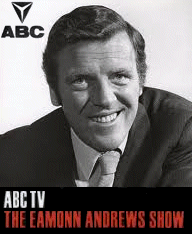
Eamonn Andrews joined ABC Television in 1964 and launched World of Sport and The Eamonn Andrews Show
'Live From London,' boomed the voice, 'The Eamonn Andrews Show... and in tonight's show...'
I was asked to leave my producer's job in Manchester to work on it, and what a great 'crack', as Eamonn might say, it really was.
For four years, I met, entertained and wrote for the world's biggest stars, from Bing Crosby to Raquel Welch. Her manager told me that on the show she would be wearing 'not so much a mini-skirt, more a Band Aid'.
My home was still in the North, but in 1968 my wife and I decided it was time to move south with our three children, the last just twelve months old.
That was the year the government decided to reallocate the ITV broadcasting franchises.
I was at Eamonn's riverside home in Chiswick, along with Brian Tesler, waiting for the call which would tell us the result. ABC had lost. There would be a 'forced marriage' with London contractor Rediffusion. The result would be Thames Television, which became the weekday contractor for London for the next twenty-three years. Although I have always been freelance, I had had a contract with ABC since the late 1950s. And that contract ceased to exist when Thames Television was born.
So there we were, in the winter of 1968, myself, my wife Patti and our three children, sitting in the kitchen of our newly purchased home in Richmond, Surrey, with Dad out of work for the first time in his life.
Life was re-born at that very moment.
I was in a situation which certainly galvanised the mind. I had two points of television logic and experience on which to work. The first was that Thames Television, the new company, were left with Eamonn Andrews - the star whose poaching from the BBC ABC had trumpeted - without a network show. So desperate were they, they dispatched a senior executive to cull the vast television ocean of America in the hope of finding a species as rare as This Is Your Life.
At my home just over the footbridge across the Thames from the Teddington studios, my mind went back to the days of the Life I had watched back in the North. It had been compulsive viewing for anyone with a TV set.
Like every programme then, it was in black and white.
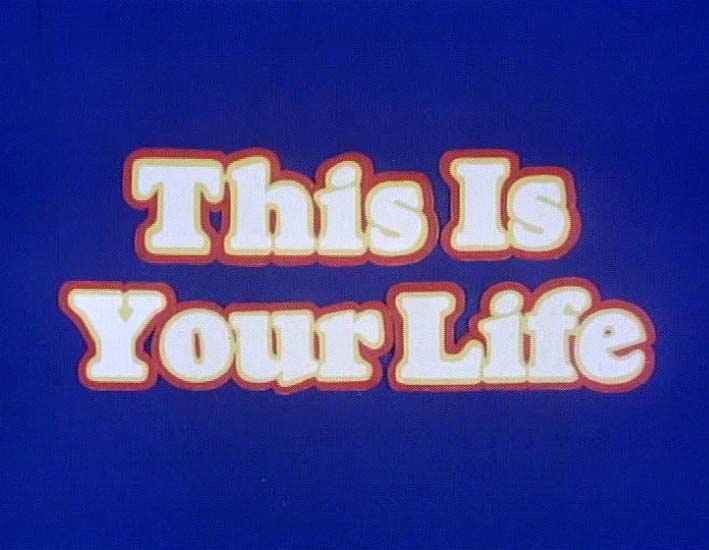
A reallocation of the ITV franchises ignites the possibility of launching a new colour version of This Is Your Life
And that led to my second idea. At long last, colour television was to be launched in November 1969. After scribbling down ideas all day, after supper I turned to Patti and said, 'Would you watch a programme called "This Is Your Colourful Life"?' She agreed instantly that to bring back Eamonn fronting that marvellous TV vehicle was a great idea. But 'colourful life'?
I explained that it might have more chance of getting past the powers that be if it appeared to be launched in tandem with a massive marketing campaign to persuade people to ditch their old black and white sets and dash out and buy or hire the new colour TVs. Hard to imagine now, but 'who needs a colour TV?' was a common expression. Rather like only a few short years ago when people were saying, 'But who wants satellite TV?'
It was one of those ideas I had nearly talked myself out of by next morning. I could hear all the executive arguments. At the launch of a brand new ITV company, Thames Television, with a franchise to broadcast to the capital, and to the network, five days a week, was this all they could come up with? A rehash of a programme the dull old Auntie BBC had taken off the air back in 1964?
I tested the water with Eamonn, who took the idea to Brian Tesler. Brian had given me my first break in television, in 1958, selecting me from a shortlist of experienced journalists to be producer of ABC TV's regional flagship current affairs programme ABC of the North. He it was who brought me to London to work on the late night Sunday chat show, and at his behest, I had returned north for a brief spell, to be editor of ABC's news and current affairs. I had not let him down.
Eamonn rang to arrange to meet me in my local pub in Richmond. When I walked in, just after opening time, he was already there, wearing that famous lop-sided grin.
'Brian will give us a pilot and six shows after if he likes it,' smiled Eamonn. He had even more to smile about. Unknown to me he had let his first-option rights to present the programme in England lapse. In the intervening few days he had flown to Los Angeles to meet up with Ralph Edwards and ensure those rights were once again secured.
Six programmes have now become six hundred.
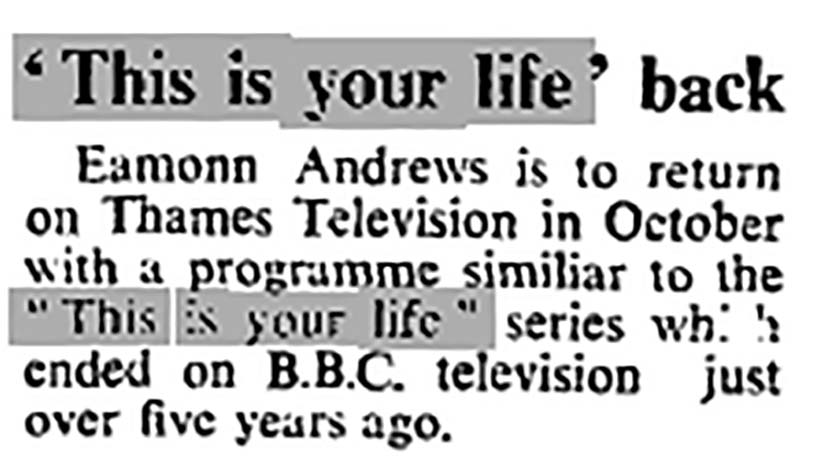
The Times 16 June 1969
Eamonn Andrews is to return on Thames Television in October with a programme similar to the This Is Your Life series which ended on BBC television, just over five years ago.
But who was to be the all-important first? Not necessarily the first programme viewers would see, but the show we recorded as the 'pilot', the try-out show to impress the top brass?
No one had any idea who the very first ITV subject to be transmitted on the network would be (I had a good idea, but kept it under wraps for reasons to be explained).
Eamonn, in his early BBC years, had had the advantage of carrying on Ralph Edwards's tradition (based on original inspiration) of bringing about a reunion of war veterans, not only with their families and friends but with their courageous wartime comrades. We were now two decades on. But Eamonn, rightly, insisted on looking for a first subject to record whose story was one of determined triumph over inconceivable odds.
My mind went back to the very title of this chapter: Birth of Life. To the blank, wheelchair-bound hopelessness of that very first subject of the Life on radio in 1946: paraplegic war veteran Lawrence Tranter.
Where was the story which encapsulated every ingredient of the original This Is Your Life?
For this try-out pilot programme in the harsh, commercial, realistic world of ITV, there was no room for a 'leak' or 'runner'. This was real Life.
Truly I forget the many names that were pitched, most of whom Eamonn had 'done' years ago at the BBC. I thought long and hard and went back to the fundamentals of the programme which had once held the nation's viewers spellbound. I tried to remember stories I had covered in my newspaper days in the north. Was there something there I was overlooking since my transition to the glamorous world of television and show business?
Indeed there was. The first subject of This Is Your Life on Thames Television was - literally - staring me in the face.
And from a wheelchair.
His name was Harry Driver. With his writing partner Vince Powell he created such television comedy gems as For the Love of Ada and Nearest and Dearest (for which I was later to co-write both TV and film). Vince still turns in great popular comedy such as Ne'er The Twain. He and Harry had been a semi-pro double act in the northern clubs. Then Harry, married with two children, was taken ill. Polio was diagnosed. He was confined to an iron lung.
A working-class northerner of great pride, he was determined to remain the family breadwinner. If he could not perform comedy, he would write it. If he could not sell his written comedy, he would write drama?
But how? His paralysis meant he could not even use his fingers, but in his mouth he could hold a knitting needle. With that knitting needle he could tap the keys of a portable electric typewriter.
And as a young journalist in Manchester, I wrote an article about Harry.
With his partner, he had persevered, against all odds, to write some of the most successful comedies on British television, including one which took the nation by storm: Love Thy Neighbour, the first white-family-next-door-to-black-family comedy.
I had worked with Harry and Vince when an original script I had co-written for Hylda Baker (about a northern pub landlady, based on my own mother) was, for want of a better word 'fused' into Nearest and Dearest. I'll never forget Hylda, at a swish West End restaurant, telling the wine waiter how much she liked the wine. 'This sparkling Bordeaux, where does it come from?'
Anyway, the idea of a man in a wheelchair with a great Northern sense of humour became the first try-out subject of Thames Television's recording of This Is Your Life.
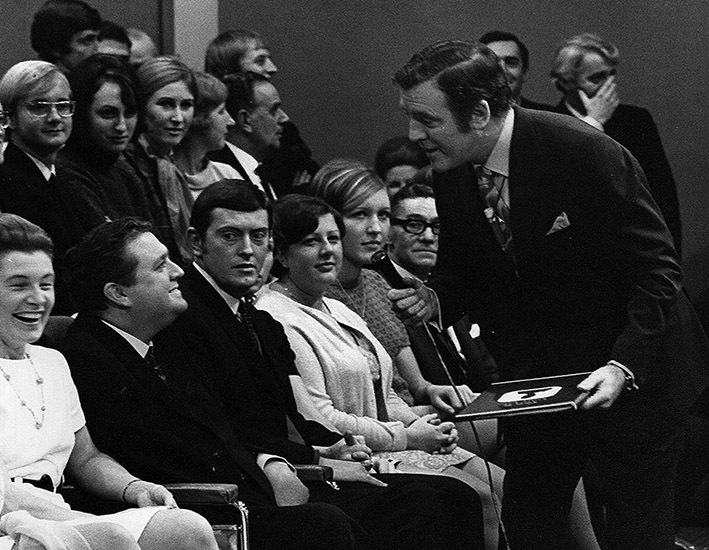
Scriptwriter Harry Driver was the subject of the first edition of This Is Your Life to be recorded by Thames Television
The newly built studios at Euston Road were not ready, so we recorded the programme at the Burlington Hotel in the West End. It was a huge success. What's more, it was in colour [Bigredbook.info editor: the programme was actually recorded at the Bloomsbury Centre Hotel].
My concept of 'This Is Your Colourful Life' had been dropped, without any argument from me; after all, the message had got through.
We had a start.
But Eamonn, as he did to the very end, still harked back to the days of live television. He loved the Harry Driver Life, but he didn't want to come back on air, on ITV, with a recorded programme.
At our meeting the next day he thumped the table: 'That was good, very good. But I want our first transmission on the ITV network to be live.'
But who? And how? Scanning the Evening Standard I spotted a London Palladium advertisement announcing that Des O'Connor was opening there in the week of our first broadcast.
Not for the first - or the last - time did Eamonn mutter: 'But is he big enough?' I convinced him we should do the Life on Des with a ploy Eamonn seized on – he would walk on stage at the Palladium and we would do the programme right there and then, live from that world-famous theatre.
But the Curse of the First Life struck again; this time not a leak to the press, but a far more bizarre situation.
Everything was fixed with the Palladium management for the evening of 19 November 1969. Guests who would appear on the show had assembled at Thames Television HQ. They were ushered into a luxury coach to be taken to the theatre.
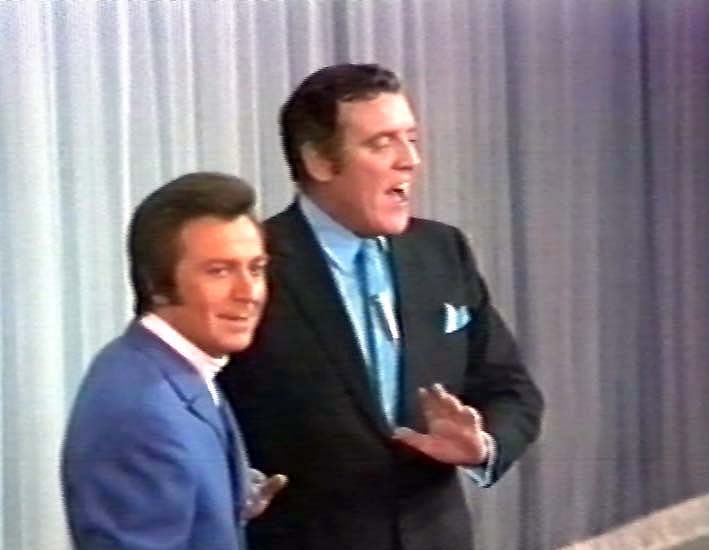
Entertainer Des O'Connor was surprised on stage at the London Palladium
At that very moment Des O'Connor was strolling from his dressing room and heading towards the stage door to take a breath of the evening air before going on stage.
A set of traffic lights, less than a hundred yards away, turned to red.
A coach stopped. Our coach.
Des blinked. Did he recognise a familiar face or two? Or was it a trick of the imagination?
Before he could get a closer look, the lights changed and the coach drove off.
On board was every single surprise guest. Fortunately we remained oblivious to the incident until after the show, by which time it had been confirmed to Des that he hadn't been hallucinating.
It wasn't long before the Life was hitting Number One in the ratings. Our promise of a 'pilot' and six shows was to become one of the longest runners on television.
Eamonn presented the show for eighteen years on Thames Television. I also acted as his consultant in the highly successful revival of What's My Line? again for Thames Television. Yet sometimes I wondered if he wasn't still, at heart, a BBC man. Had the BBC axe not been poised over the Line and Life I doubt if Eamonn would have 'defected'. Ironically, on his first-ever Eamonn Andrews Show for ITV, his trousers were held up by a pair of grey braces – stamped 'Property of the BBC'. But he wasn't any more; nor was he ever again.
As we took our places around the Life conference table one morning in 1986, during the BBC's celebrations of fifty years of television, Eamonn slipped a note to me. It was handwritten in the green ink that was his trademark. 'Roy, could you write a piece along these lines and place it, say, with the Sunday Times?'
I showed the note to no one, but I kept it. It began: 'Is somebody trying to tell us something? In the BBC's recent nostalgia splurge, who appeared more often than anyone else? Eamonn Andrews.
We saw him on Crackerjack, on What's My Line?, and a This Is Your Life saluting Harry Secombe. Even David Frost did an impression of him. Then bang up-to-date 1986-style Ludovic Kennedy on Did You See? did a sparkling in-depth mini documentary on his current series. To crown it all, Robert Robinson featured him on Tuesday night in The Magic Rectangle - an anatomy of the television personality in which many BBC star names were featured. Yet when BBC Chief Bill Cotton chose a name he picked Eamonn. "Make no mistake," he said, "Eamonn Andrews is a very clever man. A very clever man."
Eamonn's note then added: 'Hasn't anybody told them he signed up with Thames TV (then ABC TV) in 1964?'
So what, through me, was Eamonn trying to tell the BBC? That his contract was coming up for renewal (which it was)? I don't know. I never got around to writing the piece - I was far too busy with Eamonn's scripts - and he never mentioned the subject again.
In fact, his new contract for a further three years with Thames was agreed the following year, but by that time Eamonn's health had begun to deteriorate rapidly.
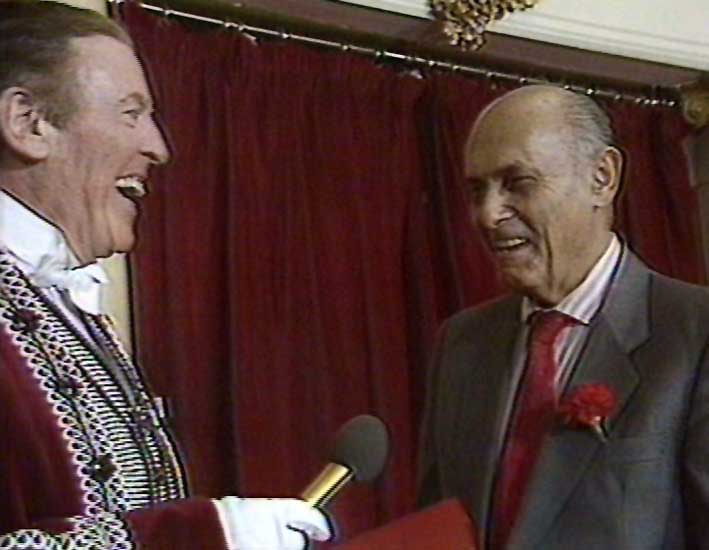
Eamonn Andrews dressed as a Royal Opera House 'flunkey' to surprise conductor, Sir Georg Solti
But his almost youthful enthusiasm for the programme remained. To surprise conductor Sir Georg Solti, I suggested he disguise himself as a Royal Opera House 'flunkey', complete with white wig, gaiters and buckled shoes. Eamonn, despite looking thin and gaunt, was game.
When the car taking him to the Opera House in Covent Garden got stuck in a West End traffic jam, he wanted to dash from the car to the nearest tube station – still dressed as a flunkey. Now that really would have stopped the traffic!
Eamonn's wife Grainne, by the way, hated the disguises we dreamed up for Eamonn for the pick-up. She told me they made her cringe. Apart from that one reservation, though, she had been a wonderful star-deflating ally of mine from the very early days of my starting to work with Eamonn.
The first time I delivered a script to Eamonn at their home beside the river in Chiswick, I wore a pair of very tight black trousers, mohair and silk, my first piece of reckless personal spending after signing my new contract.
Introduced to Grainne, I froze. In those days there was no question she could have stepped in as Elizabeth Taylor's double. A stunning woman, with a tinkling laugh and those Irish eyes.
I dropped the script. When I bent down to pick it up, the new trousers, with a noise that seemed to come from the soundtrack of a Carry On film, split right down my backside. I paused in mid pick-up; my blushes were in technicolour. Eamonn just looked at me. Grainne burst into a peal of infectious laughter which, in seconds, had us all holding our sides. Or, in my case, my back sides.
We fast-forward to November 1987. Though we had only just started to record a new season of twenty-six programmes, Grainne had persuaded Eamonn to take a short, health-boosting break in Lanzarote to celebrate their thirty-sixth wedding anniversary.
This was to be immediately after we had surprised former Wales and British Lions scrum-half Cliff Morgan, now head of Outside Broadcasts at the BBC, at the Hilton Hotel in Park Lane, venue for a BBC Sport celebration dinner.
But Eamonn was having severe respiratory problems and he was rushed to the private Cromwell Road hospital. He insisted he would do the show.
'Only from a wheelchair,' said a nurse.
We postponed the programme. Nevertheless, Eamonn still sent for scripts to read in his hospital bed. With Grainne, he even watched that week's edition of the Life.
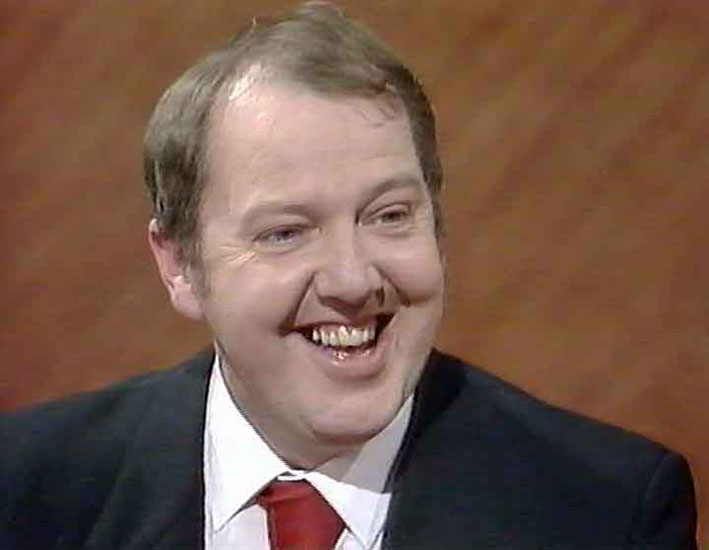
Eamonn Andrews surprised comedian Jimmy Cricket in September 1987
It was Irish comedian Jimmy Cricket, the last Life Eamonn would ever see.
He could afford a special chuckle, because we nearly lost that show. In the middle of Oxford Circus the day before the programme, Jimmy accidentally bumped into our surprise fly-in from Australia.
I broke the news to Eamonn in the office at Thames Studios at Teddington.
He shook his head in disbelief.
'A ten million to one chance,' he sighed. 'It could only happen to an Irishman. What do we do?' I invented an excuse for the visitor to have been there without contacting him. 'Jesus, Mary, and Joseph,' muttered Eamonn.
Whispered our Catholic production secretary: 'For a Catholic, that's serious.'
In the Cromwell Hospital he saw his final credit roll: This Is Your Life. Presented by Eamonn Andrews. Grainne kissed him on the cheek and left him to sleep.
My own sleep was broken at 3 a.m. on 5 November 1987, to tell me the Big Fella would never wake up.
Another call. A car was on its way from the studios of TV-AM for me to pay tribute to Eamonn. I was in a total daze. After the TV appearance, the car took me to Teddington Studios. Everyone who had ever worked with Eamonn was in a state of shock.
Terry Wogan came in to present a Thames tribute that night, during which we re-ran the Thames This Is Your Life on Eamonn.
It was difficult to come to terms with the fact that his life was over.
The official cause of death was 'progressive deterioration of the heart muscle'. Grainne told me at the family funeral in Portmarnock: 'I think it was more a case of a broken heart.'
She would not be drawn, but I believe she was referring to four years of financial turmoil and unsuccessful business ventures taking their toll. She also blamed that for the death of her father, Lorcan. 'His spirit was broken,' she said.
Within eighteen months, Grainne Andrews had passed away herself. Cancer was the official cause. Personally, when she was laid to rest by Eamonn's side in the hillside cemetery at Portmarnock, I thought there were two broken hearts.
For they had always beaten as one.